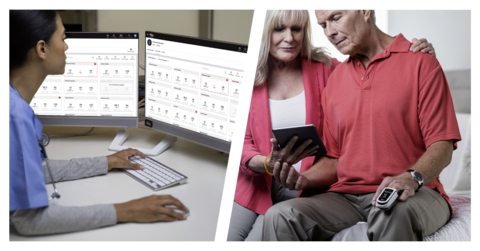New Study Finds That Remote Patient Monitoring with Masimo SafetyNet® Significantly Reduced Rates of Hospital Readmission and ED Visits for Patients Recuperating at Home After Joint Replacement Surgery

Masimo SafetyNet® and MightySat® (Photo: Business Wire)
Noting that while the trend toward performing TJA as outpatient surgery reduces hospital length of stay (LOS), the practice decreases “available time to monitor for postoperative complications,”1 the authors sought to investigate whether equipping patients with RPM could offer the best of both worlds: outpatient surgery with the ability to track vital signs and more easily stay in touch with patients while they recuperate at home. They enrolled 100 patients who were scheduled to undergo total knee or total hip surgery at SLUHN, divided into two groups: 50 who did not receive RPM after discharge (2021-2022), and 50 who did (2022-2023). Various characteristics (demographics such as age, gender, race, BMI, and marital status; hospital LOS; ASA score; and Charlson Comorbidity Index) were compared between the cohorts and there were no significant differences (p > 0.05), although hospital LOS was slightly shorter in the RPM group (29.4 hours vs. 30.4 hours).
Patients in the RPM cohort were discharged with a Masimo MightySat® pulse oximeter and an Omron blood pressure monitor, provided by Masimo, which connected wirelessly to the Masimo SafetyNet app. For 48 hours after discharge, patients checked their vital signs four times daily. Data recorded by Masimo SafetyNet (including manually entered temperature data) were automatically uploaded to the hospital’s virtual response center for review by hospital clinicians, who reached out to patients as needed to address abnormalities or signs of physiological decline, provide guidance, and, if warranted, recommend returning to the facility for in-person care. Patients in the control group, who did not receive RPM, were discharged with routine TJA postoperative instructions.
The researchers found that in the RPM cohort, 10 patients (
Although they did not conduct a formal cost analysis of the RPM program, the authors estimated that, after taking into account the potential cost avoidance of fewer hospital readmissions, for every 1,000 TJA surgeries performed, the RPM program “could potentially result in a hospital savings of
The researchers also surveyed patients in the RPM cohort about their experience and found that most held a favorable view of the program:
The authors concluded, “As total joint replacements are increasingly being performed in the outpatient setting, postoperative patient monitoring from home is a feasible way to help mitigate readmissions in the postoperative period. The utility of a virtual response center would be to identify, in real time, certain patient metrics that could indicate potential complications and ultimately allow for more timely intervention that may prevent morbidity and readmissions. Efforts to minimize costs should not be implemented at the expense of patients’ health outcomes with a goal to find an appropriate balance between both agendas.”1
Masimo SafetyNet is not intended to be used for real-time monitoring.
@Masimo | #Masimo
About Masimo
Masimo (NASDAQ: MASI) is a global medical technology company that develops and produces a wide array of industry-leading monitoring technologies, including innovative measurements, sensors, patient monitors, and automation and connectivity solutions. In addition, Masimo Consumer Audio is home to eight legendary audio brands, including Bowers & Wilkins, Denon, Marantz, and Polk Audio. Our mission is to improve life, improve patient outcomes, and reduce the cost of care. Masimo SET® Measure-through Motion and Low Perfusion™ pulse oximetry, introduced in 1995, has been shown in over 100 independent and objective studies to outperform other pulse oximetry technologies.2 Masimo SET® has also been shown to help clinicians reduce severe retinopathy of prematurity in neonates,3 improve CCHD screening in newborns,4 and, when used for continuous monitoring with Masimo Patient SafetyNet™ in post-surgical wards, reduce rapid response team activations, ICU transfers, and costs.5-9 Masimo SET® is estimated to be used on more than 200 million patients in leading hospitals and other healthcare settings around the world,10 and is the primary pulse oximetry at all 10 top
RPVi has not received FDA 510(k) clearance and is not available for sale in
References
- DeRogatis MJ, Pellegrino AN, Wang N, Higgins M, Dubin J, Issack P, Sokunbi G, Brogle P, Konopitski A. Enhancing recovery and reducing readmissions: The impact of remote monitoring on acute postoperative care in outpatient total joint arthroplasty. J Ortho. 26 June 2024. 58(2024). DOI: 10.1016/j.jor.2024.60.028.
- Published clinical studies on pulse oximetry and the benefits of Masimo SET® can be found on our website at http://www.masimo.com. Comparative studies include independent and objective studies which are comprised of abstracts presented at scientific meetings and peer-reviewed journal articles.
- Castillo A et al. Prevention of Retinopathy of Prematurity in Preterm Infants through Changes in Clinical Practice and SpO2 Technology. Acta Paediatr. 2011 Feb;100(2):188-92.
- de-Wahl Granelli A et al. Impact of pulse oximetry screening on the detection of duct dependent congenital heart disease: a Swedish prospective screening study in 39,821 newborns. BMJ. 2009;Jan 8;338.
- Taenzer A et al. Impact of pulse oximetry surveillance on rescue events and intensive care unit transfers: a before-and-after concurrence study. Anesthesiology. 2010:112(2):282-287.
- Taenzer A et al. Postoperative Monitoring – The Dartmouth Experience. Anesthesia Patient Safety Foundation Newsletter. Spring-Summer 2012.
- McGrath S et al. Surveillance Monitoring Management for General Care Units: Strategy, Design, and Implementation. The Joint Commission Journal on Quality and Patient Safety. 2016 Jul;42(7):293-302.
- McGrath S et al. Inpatient Respiratory Arrest Associated With Sedative and Analgesic Medications: Impact of Continuous Monitoring on Patient Mortality and Severe Morbidity. J Patient Saf. 2020 14 Mar. DOI: 10.1097/PTS.0000000000000696.
- Estimate: Masimo data on file.
- https://www.newsweek.com/rankings/worlds-best-hospitals-2024/united-states
Forward-Looking Statements
This press release includes forward-looking statements as defined in Section 27A of the Securities Act of 1933 and Section 21E of the Securities Exchange Act of 1934, in connection with the Private Securities Litigation Reform Act of 1995. These forward-looking statements include, among others, statements regarding the potential effectiveness of Masimo SafetyNet® and MightySat®. These forward-looking statements are based on current expectations about future events affecting us and are subject to risks and uncertainties, all of which are difficult to predict and many of which are beyond our control and could cause our actual results to differ materially and adversely from those expressed in our forward-looking statements as a result of various risk factors, including, but not limited to: risks related to our assumptions regarding the repeatability of clinical results; risks related to our belief that Masimo's unique noninvasive measurement technologies, including Masimo SafetyNet and MightySat, contribute to positive clinical outcomes and patient safety; risks related to our belief that Masimo noninvasive medical breakthroughs provide cost-effective solutions and unique advantages; risks that the researchers’ conclusions and findings may be inaccurate; risks related to COVID-19; as well as other factors discussed in the "Risk Factors" section of our most recent reports filed with the Securities and Exchange Commission ("SEC"), which may be obtained for free at the SEC's website at www.sec.gov. Although we believe that the expectations reflected in our forward-looking statements are reasonable, we do not know whether our expectations will prove correct. All forward-looking statements included in this press release are expressly qualified in their entirety by the foregoing cautionary statements. You are cautioned not to place undue reliance on these forward-looking statements, which speak only as of today's date. We do not undertake any obligation to update, amend or clarify these statements or the "Risk Factors" contained in our most recent reports filed with the SEC, whether as a result of new information, future events or otherwise, except as may be required under the applicable securities laws.
View source version on businesswire.com: https://www.businesswire.com/news/home/20240729113691/en/
Media Contact:
Masimo
Evan Lamb
949-396-3376
elamb@masimo.com
Source: Masimo







